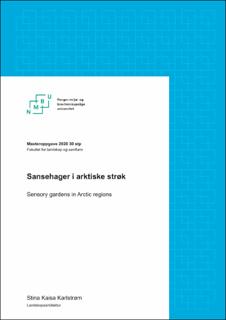| dc.contributor.advisor | Geelmuyden, Anne Katrine | |
| dc.contributor.advisor | Evensen, Katinka Horgen | |
| dc.contributor.author | Karlstrøm, Stina Kaisa | |
| dc.coverage.spatial | Norway, Finnmark | en_US |
| dc.date.accessioned | 2021-02-05T12:49:59Z | |
| dc.date.available | 2021-02-05T12:49:59Z | |
| dc.date.issued | 2020 | |
| dc.identifier.uri | https://hdl.handle.net/11250/2726441 | |
| dc.description.abstract | I Norge er det anlagt mange sansehager ved omsorgsboliger og andre institusjoner de seneste årene, hvor målet er å skape muligheter for utfoldelse og glede slik at tapet av, eller mangelen på, viktige mentale funksjoner ikke oppleves så sterkt for beboerne. Forskning viser at slike tilgjengelige og opparbeidede uterom kan bidra til høyere livskvalitet, mer selvstendighet og en mer aktiv tilværelse. Forskning viser også at det i stor grad er kulturelle og klimatiske aspekter som byr på de største bruksutfordringene. I vår nordligste landsdel er det også etablert sansehager. Tross et svært variert klima og en betydelig tilstedeværelse av både norsk, samisk og kvensk kultur, foreligger lite tilgjengelig informasjon om disse sansehagenes utforming og bruk. Gjennom en casestudie basert på dokumentanalyse, befaring og fysisk stedsanalyse samt samtaler med ansatte og landskapsarkitekter kartlegger oppgaven hvordan sansehager i arktiske strøk er planlagt og utformet samt hvordan de egner seg for bruk og hvordan de brukes. Resultatene fra casestudien viser at både de kulturelle og klimatiske faktorene spiller stor rolle i planleggingen og bruken av sansehager i nord, og at behovet for klimatilpasning varierer i forhold til de kulturelle forholdene som ligger til grunn på stedet. Casestudien viser også at sansehager som tilrettelegges for bruk om vinteren brukes om vinteren, at skjøtsel er et svært viktig tema å sette på dagsorden for å få til god bruk av en sansehage, og at det er mulig å utforme en sansehage i arktiske strøk helt uten skjøtselsbehov. På bakgrunn av funnene i casestudien foreslås en veileder for utforming og bruk av sansehager i arktiske strøk. Mens enkelte tiltak i veilederen trolig er anvendbare i store deler av landet, er flere tiltak særegne for arktiske strøk. | en_US |
| dc.description.abstract | In recent years many sensory gardens have been established in Norway, where the goal is to create opportunities for unfoldment and joy so that the loss of, or lack of, important mental functions is not experiences as strongly for the residents. Research has shown that such available outdoor spaces can contribute to a higher quality of life, independence, and a more active lifestyle for the residents. Research also shows that cultural and climatic aspects offer the most significant challenges concerning use. We can also find many sensory gardens in our northernmost part of the country. Despite a very varied climate and a significant presence of Norwegian, Sami, and Kven culture, there is little available information about the design and use of these sensory gardens. Through a case study based on document analysis, site analysis and conversations with employees and landscape architects, the thesis tries to map how sensory gardens in arctic regions are planned and designed as well as how they are suitable for use and how they are being used. The case study results show that both the cultural and climatic factors play a significant role in the planning and use of sensory gardens in Arctic regions. The need for climate adaption varies with the cultural conditions underlying the site. The case study also shows that sensory gardens adapted to winter get used during the winter months. Managing and caring for the site is an important question when planning for a sensory garden. The case study shows that it is possible to design a sensory garden in Arctic regions entirely without managing and care. Based on the case study findings, the assignment proposes a guide for sensory gardens in arctic regions. While some measures are probably applicable in large parts of the country, several criteria are specific to Arctic regions. | en_US |
| dc.language.iso | nob | en_US |
| dc.publisher | Norwegian University of Life Sciences, Ås | en_US |
| dc.rights | Attribution-NonCommercial-NoDerivatives 4.0 Internasjonal | * |
| dc.rights.uri | http://creativecommons.org/licenses/by-nc-nd/4.0/deed.no | * |
| dc.title | Sansehager i arktiske strøk | en_US |
| dc.title.alternative | Sensory gardens in Arctic regions | en_US |
| dc.type | Master thesis | en_US |
| dc.description.localcode | M-LA | en_US |

